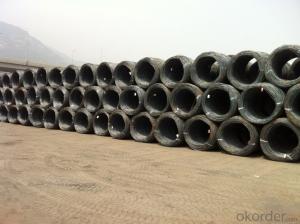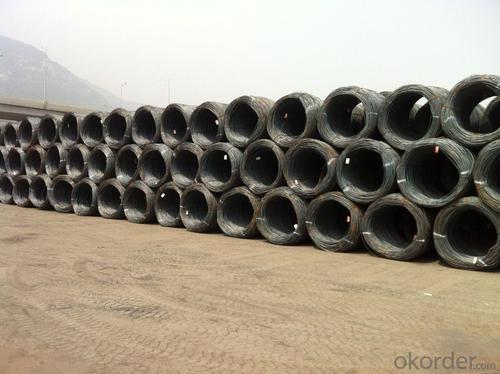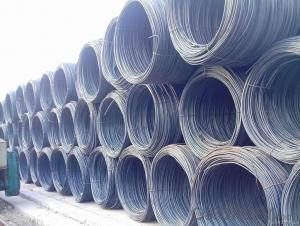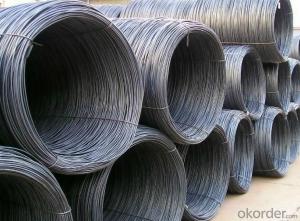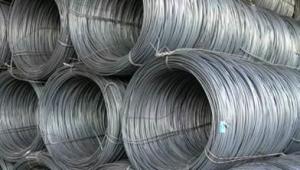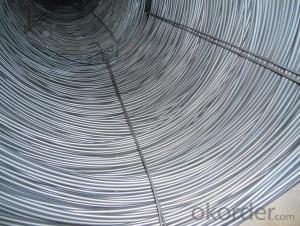American Wire rods with High Quality and Good Price
- Loading Port:
- Tianjin
- Payment Terms:
- TT or LC
- Min Order Qty:
- 25 m.t.
- Supply Capability:
- 20000 m.t./month
OKorder Service Pledge
OKorder Financial Service
You Might Also Like
Product Description:
OKorder is offering SAE1008 Wire Rods at great prices with worldwide shipping. Our supplier is a world-class manufacturer of steel, with our products utilized the world over. OKorder annually supplies products to European, North American and Asian markets. We provide quotations within 24 hours of receiving an inquiry and guarantee competitive prices.
Product Applications:
SAE1008 Wire Rods are ideal for structural applications and are widely used in the construction of buildings and the manufacturing, industries.
Product Advantages:
OKorder's Wire Rods are durable, strong, and resist corrosion.
Main Product Features:
· Premium quality
· Prompt delivery & seaworthy packing (30 days after receiving deposit)
· Corrosion resistance
· Can be recycled and reused
· Mill test certification
· Professional Service
· Competitive pricing
Product Specifications:
Manufacture: Hot rolled
Grade: SAE1006 – SAE1008
Certificates: ISO, SGS, BV, CIQ
Length: 6m – 12m, as per customer request
Packaging: Export packing, nude packing, bundled
Grade | Chemical Composition (%) | |||||
C | Mn | S | P | Si | B | |
SAE1006B | 0.03~O.07 | 0.32max | 0.045max | 0.040max | 0.30max | 0.0008min |
Mechanical properties | ||||||
Yield strength(N/mm2) | Tensile strength(N/mm2) | Elongation (%) | ||||
250-280 | 350-380 | ≥32 | ||||
Grade | Chemical Composition (%) | |||||
C | Mn | S | P | Si | B | |
SAE1008B | 0.10max | 0.3~0.50 | 0.050max | 0.040 max | 0.15max | 0.0008 min |
Mechanical properties | ||||||
Yield strength(N/mm2) | Tensile strength(N/mm2) | Elongation (%) | ||||
≥195 | 315-430 | ≥30 | ||||
FAQ:
Q1: How soon can we receive the product after purchase?
A1: Within three days of placing an order, we will begin production. The specific shipping date is dependent upon international and government factors, but is typically 7 to 10 workdays.
Q2: How do we guarantee the quality of our products?
A2: We have established an advanced quality management system which conducts strict quality tests at every step, from raw materials to the final product. At the same time, we provide extensive follow-up service assurances as required.
A3: Stainless does not "rust" as you think of regular steel rusting with a red oxide on the surface that flakes off. If you see red rust it is probably due to some iron particles that have contaminated the surface of the stainless steel and it is these iron particles that are rusting. Look at the source of the rusting and see if you can remove it from the surface.
Images:
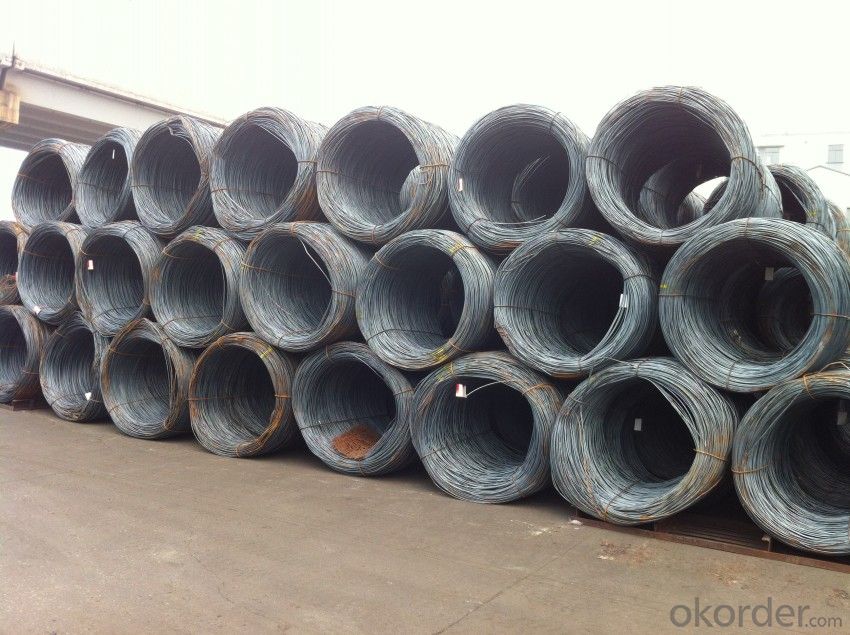
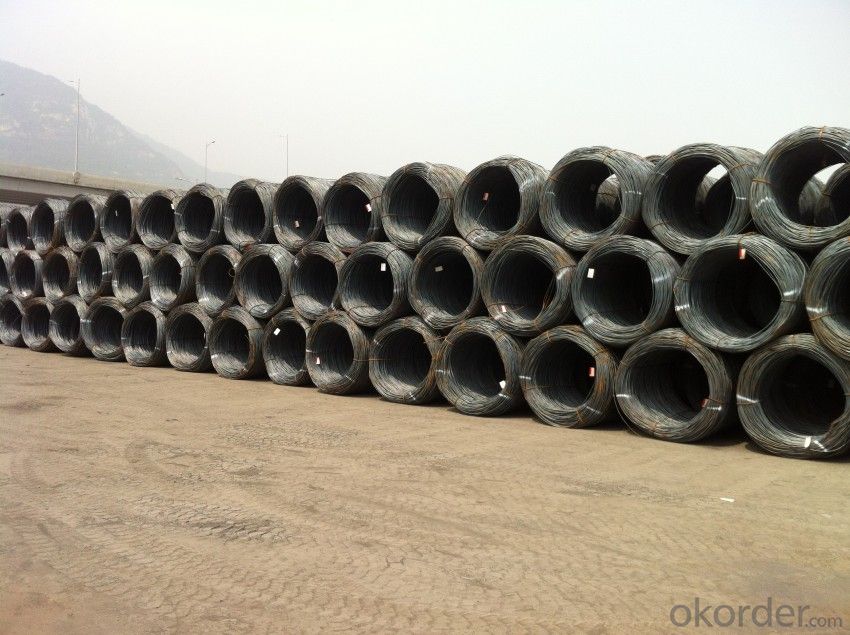
- Q: What are the different types of surface coatings available for steel wire rod?
- Steel wire rods can be coated in several ways to achieve different objectives. These coatings serve various purposes, including protection against corrosion, enhancing appearance, and improving performance. Some common types of surface coatings for steel wire rods are as follows: 1. Zinc Coating: Steel wire rods are often protected from corrosion using zinc coatings. The most commonly used technique is hot-dip galvanizing, which involves immersing the wire rod in molten zinc. This coating offers excellent resistance to corrosion and can withstand harsh environmental conditions. 2. Phosphate Coating: Phosphate coatings are applied to steel wire rods to enhance their adhesion properties and provide a base for subsequent coatings or paints. These coatings improve the wire's corrosion resistance and its ability to bond with other materials. 3. Polymer Coating: Polymer coatings are used to create a protective barrier against corrosion and physical damage on steel wire rods. These coatings are particularly useful in applications where the wire needs to endure harsh conditions or have increased durability. Polymer coatings can be tailored to possess specific properties such as resistance to abrasion, chemicals, or UV rays. 4. Epoxy Coating: Epoxy coatings are commonly used to protect steel wire rods that will be exposed to corrosive environments. These coatings offer excellent resistance to chemicals, moisture, and abrasion. Industries such as marine, oil and gas, and automotive frequently employ epoxy coatings. 5. PVC Coating: Steel wire rods can be coated with PVC (Polyvinyl Chloride) to provide insulation and protection against corrosion. This type of coating is commonly used in electrical applications where the wire requires electrical insulation and protection from environmental factors. 6. Powder Coating: Powder coatings are applied to steel wire rods using electrostatically charged powder particles that adhere to the wire's surface. These coatings offer exceptional durability, corrosion resistance, and can be customized with different colors or finishes. Selecting the appropriate surface coating for steel wire rods is crucial, and it should be based on the specific requirements of the application and the environment in which the wire will be used. Each type of coating has its own advantages and limitations, so careful consideration must be given to choosing the most suitable coating for the intended purpose.
- Q: How is steel wire rod used in the production of wire for automotive seat springs?
- Steel wire rod is an essential component in the production of wire used for automotive seat springs. The wire rod is initially processed through a series of steps to enhance its strength, durability, and flexibility. This involves heating and cooling the rod to achieve the desired mechanical properties. Once the steel wire rod has been processed, it is then further drawn down to the required diameter for the seat springs. This drawing process involves pulling the wire rod through a series of dies, reducing its diameter while increasing its length. This step is crucial in achieving the desired mechanical properties and ensuring the wire is strong enough to withstand the stress and pressure of automotive seat springs. After the wire has been drawn down to the desired diameter, it is then shaped into the specific coil form of the seat springs. Using specialized machinery, the wire is coiled and formed into the desired shape, ensuring it meets the design requirements and provides the necessary support and comfort for automotive seats. The use of steel wire rod in the production of wire for automotive seat springs is crucial due to the material's high tensile strength and excellent resistance to fatigue and corrosion. These properties ensure that the wire can withstand the constant pressure and movement experienced by automotive seat springs, providing long-lasting performance and durability. Furthermore, steel wire rod offers the advantage of being cost-effective and readily available, making it a preferred choice for automotive manufacturers. Its versatility allows for customization, enabling the production of wire with specific characteristics tailored to meet the requirements of different types of seat springs. In summary, steel wire rod plays a vital role in the production of wire for automotive seat springs. Through various processing steps, the wire rod is transformed into high-quality wire that possesses the necessary strength, durability, and flexibility to support and provide comfort to automotive seats.
- Q: What are the main trade associations and organizations in the steel wire rod industry?
- Some of the main trade associations and organizations in the steel wire rod industry include: 1. American Wire Producers Association (AWPA): This trade association represents the interests of wire producers, suppliers, and consumers in North America. They work towards promoting the use of wire products and advancing the industry through advocacy, education, and networking. 2. International Wire & Machinery Association (IWMA): IWMA is a global association that brings together wire and cable manufacturers, suppliers, and machinery companies. They organize events, conferences, and exhibitions to facilitate networking and knowledge sharing among industry players. 3. Wire Association International (WAI): WAI is a non-profit association dedicated to promoting the interests of the wire and cable industry worldwide. They offer technical resources, training programs, and industry updates to their members, fostering collaboration and innovation in the steel wire rod sector. 4. International Iron and Steel Institute (IISI): While not specific to the wire rod industry, IISI represents the global steel industry, including producers, distributors, and other stakeholders. They provide a platform for industry collaboration, policy advocacy, and information exchange. 5. Steel Wire Manufacturers Association (SWMA): SWMA is a trade association that represents wire manufacturers in the United States. They advocate for fair trade practices, provide technical expertise, and promote the use of wire products in various industries. These organizations play a crucial role in advancing the steel wire rod industry by providing a platform for collaboration, knowledge sharing, and advocacy. They contribute to the growth and development of the industry while ensuring the sustainability and competitiveness of its members.
- Q: What are the transportation options for steel wire rod?
- The transportation options for steel wire rod typically include trucking, rail transport, and sometimes even shipping by sea or air for long-distance or international deliveries.
- Q: How is steel wire rod used in the manufacturing of wire for reinforced concrete structures?
- Steel wire rod is an essential component in the manufacturing of wire for reinforced concrete structures because it serves as the raw material for producing the wire. The rod is first drawn through a series of dies to reduce its diameter, creating the desired wire thickness. This wire is then further processed and treated to enhance its strength and durability. Finally, the wire is bundled and used to reinforce concrete structures, such as beams, columns, and slabs, providing tensile strength and improving the overall structural integrity.
- Q: What are the strength requirements for steel wire rod used in suspension bridge wire strands?
- The strength criteria for steel wire rod utilized in the wire strands of suspension bridges can differ based on various factors. Typically, the wire rod must possess a high level of tensile strength to endure the immense loads and stresses that suspension bridges encounter. The wire rod must have a minimum yield strength and ultimate tensile strength that either meets or surpasses the design requirements for the suspension bridge. The yield strength signifies the amount of stress that the wire rod can tolerate before it permanently deforms, while the ultimate tensile strength indicates the maximum stress the wire rod can withstand before it breaks. In addition to high strength, the wire rod must also demonstrate good ductility and toughness. Ductility refers to the material's ability to deform without fracturing, while toughness is its capacity to absorb energy without fracturing. These properties are vital for maintaining the structural integrity of the wire strands, as they allow the strands to flex and absorb dynamic loads, such as wind or vehicle vibrations, without experiencing failure. Furthermore, the wire rod should possess excellent corrosion resistance to ensure the longevity and durability of the suspension bridge. Over time, corrosion can weaken the wire strands, which compromises the bridge's structural integrity. Therefore, the wire rod must have a protective coating or be composed of corrosion-resistant alloys that can withstand exposure to environmental factors like moisture, saltwater, and pollutants. Lastly, the wire rod's dimensional requirements, including its diameter and surface finish, must also adhere to the specifications of the suspension bridge design. These dimensions are crucial for maintaining the desired strength and performance characteristics of the wire strands. In conclusion, the strength requirements for steel wire rod used in suspension bridge wire strands encompass high tensile strength, good ductility, toughness, corrosion resistance, and compliance with dimensional specifications. By meeting these requirements, the wire strands are capable of withstanding the significant loads and environmental conditions experienced by suspension bridges, ensuring their structural integrity and safety.
- Q: How is steel wire rod used in the manufacturing of wire forms for transportation vehicles?
- Steel wire rod, known for its strength, durability, and flexibility, plays a crucial role in the manufacturing of wire forms for transportation vehicles. These wire forms serve various purposes, including the production of springs, suspension systems, cables, and other essential components. When it comes to transportation vehicles, springs are one of the primary applications of steel wire rod. Springs are responsible for absorbing shocks and vibrations, ensuring stability and comfort for the vehicle. Manufacturers commonly use steel wire rod to create different types of springs, such as coil springs, leaf springs, and torsion bars. The excellent tensile strength and elasticity of steel wire rod enable these springs to withstand heavy loads, providing a smooth and reliable ride. Another important application of steel wire rod in transportation vehicles is in the production of suspension systems. These systems serve the purpose of supporting the vehicle's weight and maintaining contact between the tires and the road surface. Steel wire rod is utilized to manufacture suspension components like stabilizer bars and control arms, which enhance the vehicle's handling, stability, and overall performance. Steel wire rod is also crucial in the manufacturing of cables for transportation vehicles. Cables are essential for various functions, such as operating brakes, accelerators, and clutch systems. The high strength and durability of steel wire rod ensure that these cables can withstand the forces and stresses involved in vehicle operation, providing reliable and precise control. Additionally, steel wire rod finds applications in the production of other wire forms, including wire mesh and wire ropes, within transportation vehicles. Wire mesh reinforces structures, provides protection, and enhances safety. On the other hand, wire ropes are utilized for lifting heavy loads, towing, and securing cargo. In conclusion, steel wire rod is an indispensable material in the manufacturing of wire forms for transportation vehicles. Its strength, durability, and flexibility make it suitable for a wide range of applications, including springs, suspension systems, cables, and other critical components. By utilizing steel wire rod, transportation vehicles can ensure safety, reliability, and optimal performance.
- Q: How does the electrical conductivity of steel wire rod vary with different wire drawing processes?
- The electrical conductivity of steel wire rod typically decreases with each wire drawing process. This is because the mechanical deformation during the drawing process causes the crystal structure of the steel to become more elongated and aligned, resulting in increased resistance to electrical flow. Additionally, impurities and oxides on the surface of the wire rod can be further compacted during wire drawing, further reducing electrical conductivity.
- Q: How is steel wire rod used in the manufacturing of screws and bolts?
- Steel wire rod is used in the manufacturing of screws and bolts as it serves as the primary raw material. The wire rod is first drawn into the desired diameter and then cut into specific lengths to create the base material for screws and bolts. This wire is then further processed through various manufacturing processes, including heading, threading, and heat treatment, to shape and strengthen it into the final product. So, steel wire rod is an essential component that provides the necessary strength and durability to screws and bolts.
- Q: How does the ductility of steel wire rod vary with different heat treatment processes?
- The ductility of steel wire rod can be significantly influenced by different heat treatment processes. Heat treatment can involve processes such as annealing, quenching, and tempering, which can alter the microstructure and mechanical properties of the steel wire rod. Annealing is a heat treatment process that involves heating the steel wire rod to a specific temperature and then slowly cooling it down. This process helps to relieve internal stresses and refine the grain structure of the steel. As a result, the ductility of the steel wire rod tends to increase after annealing. The increased ductility is due to the reduction in dislocations and the formation of a finer grain structure, which allows for greater plastic deformation before fracture. Quenching, on the other hand, involves rapidly cooling the steel wire rod from a high temperature to room temperature or below. This process causes a sudden transformation of the microstructure, resulting in a harder and more brittle material. Consequently, the ductility of the steel wire rod decreases significantly after quenching. The rapid cooling rate during quenching leads to the formation of martensite, a hard and brittle phase, which restricts the ability of the material to undergo plastic deformation. Tempering is a heat treatment process that follows quenching, where the steel wire rod is reheated to a lower temperature and then cooled at a controlled rate. This process helps to relieve some of the internal stresses induced by quenching and allows for the transformation of some of the brittle martensite into a more ductile phase called tempered martensite. As a result, the ductility of the steel wire rod can be partially restored through tempering. The tempered martensite has a reduced hardness but retains some of the strength and hardness obtained during quenching. In summary, the ductility of steel wire rod can vary significantly with different heat treatment processes. Annealing tends to increase ductility by promoting a finer grain structure and reducing internal stresses. Quenching results in a significant decrease in ductility due to the formation of a hard and brittle martensitic structure. Tempering can partially restore ductility by transforming some of the martensite into a more ductile phase. The specific heat treatment process used, including temperature, cooling rates, and duration, will determine the extent of the changes in ductility for steel wire rod.
Send your message to us
American Wire rods with High Quality and Good Price
- Loading Port:
- Tianjin
- Payment Terms:
- TT or LC
- Min Order Qty:
- 25 m.t.
- Supply Capability:
- 20000 m.t./month
OKorder Service Pledge
OKorder Financial Service
Similar products
Hot products
Hot Searches
Related keywords
